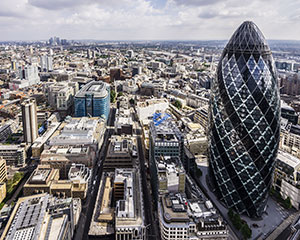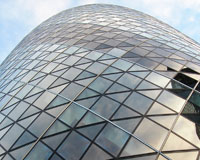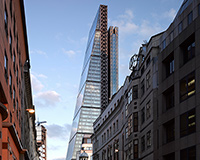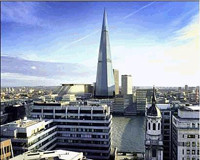
We have a Shard, a Gherkin, a Walkie Talkie and a Cheesegrater and they all have something in common – apart from being tall, that is. They are a barometer for current market trends.
Towers are not just the preserve of the banks or US lawyers any more, but have an increasingly diverse occupier base. This has as much to do with the City market generally attracting a broader spectrum of businesses as it has with companies wanting to locate in an iconic building.
Take the Leadenhall Building, or the Cheesegrater to the man in the street. It is opposite the Lloyds Building and 10 years ago its location alone would have made it the preserve of insurance firms.
Its anchor tenant, Aon, is in that line of business and the proximity to Lloyds was one of the drivers for it to take the space (see panel), but the building has also attracted firms from sectors such as financial technology, architecture and fund management – seven or eight different occupier classes, says Alex Colvin, leasing director, British Land, which jointly developed the Leadenhall Building with Oxford Properties.
“We are right opposite the Lloyds Building, a huge pull for the insurers, so that isn’t a surprise,” says Colvin. “But what has been a surprise is the wider city appeal in terms of the occupiers.”
Research by Savills shows that in the past eight years, the amount of space the banking sector has taken in towers has dropped, while space occupied by the TMT sector has increased. However, this is in line with City trends generally.
So why do occupiers want to lease space in a tower? Phillip Pearce, executive director, central London at Savills, says: “There is no one reason. Obviously, towers give a degree of profile and credibility and they are known around the world. For some smaller occupiers, there is an element of prestige and profile being in a tower.”
Floorplates are important. When it was completed in 2004, there was criticism of 30 St Mary Axe – the Gherkin – because its round shape potentially made floorplates inefficient. But if they are, it hasn’t affected occupancy and it certainly hasn’t affected the building’s investment value, trading most recently for a price tag of around £726m. The latest breed of towers have large floorplates, which suits both open plan and cellular offices. “As prestigious as the building is, it has got to work,” says Pearce.
And so far, it seems to be working. The Leadenhall Building, which has 610,000 sq ft of office space, has pushed City rent levels to a new high of £90 per sq ft on recent deals in smaller chunks of space.
A tale of two tower occupiers
Jim Herbert, chief executive at Aon, virtually bounces around the company’s new offices in British Land and Oxford Properties’ Leadenhall Building, such is his enthusiasm for the new space the company has leased. The international insurance firm is the largest occupier, taking 192,000 sq ft over 10 floors in the Rogers Stirk Harbour + Partners-designed building.
Aon began its search for new offices six or seven years ago as the lease on its Devonshire Square office, EC2, was coming to an end. It needed space for up to 2,500 people within walking distance of Lloyds of London and it wanted an iconic building – the firm was moving its global HQ from Chicago to London.
“We weren’t set on a tower and have ended up going for lower floors, but a tower made a lot of sense,” says Herbert.
The firm looked at buildings such as the Pinnacle and 20 Fenchurch Street, which Herbert describes as fantastic buildings, but it was the design of Leadenhall that swung it.
“All the workings of the building are away from the colleague space and normally you have a concrete lift shaft, but Leadenhall gave us a different floorplate,” he says. “It became an obvious first choice quite quickly.”
The large open floorplate has enabled the company to do something different. Gone are the cellular offices and in has come open-plan hot-desking. Staff have a locker each but all the desks are set up the same with docking stations for laptops. As we tour one of the floors, Herbert points out the chief operating officer sitting at a bank of six desks.
Another factor that helped sway the decision was the need to attract and retain staff. “To win in our industry, to be the market leader, we must employ the best talent,” says Herbert. “We want to make this an attractive place to work and we did a lot of research. It became apparent that the younger generation don’t want conventional space.”
Aon has its own escalators up to its reception – a journey that certainly has the wow factor. And then there is the glass lift ride up the outside of the building to its offices. Herbert describes it as “memorable but not ostentatious”.
EGTV’s cameras were given exclusive access to Aon’s offices – click here to watch the video
Serviced office provider The Office Group has a portfolio spread across central London with a notable presence in hipper locations, such as Shoreditch. Taking space in the Shard was a departure for the business, but part of a strategy to get a wider geographical spread and to have a different offer.
“It is something quite unique – it is iconic, and that was very much a driver,” says Charlie Green, co-chief executive of The Office Group. He adds that taking space in the Shard gives small firms the opportunity to occupy space they would not normally have access to, and it was a good fit for the Shard, too.
“Smaller businesses do bring a different atmosphere,” he says. “They [the Shard] wanted to widen their appeal – not just suits and ties – because our core market is creative, tech and media. The Shard was the tower we felt had the most appeal. We love London Bridge, Borough Market, it’s close to the station and, at the end of it, this building is known by everyone globally – and that has impact.”
The company chose higher floors – 24 and 25 – because of the “stunning views” and, speaking just a couple of weeks after moving in, Green says the firm is already ahead of budget in terms of leasing.
“We anticipate that the revenue we are going to get from meeting rooms and conferencing will be better than anywhere else,” he adds.













